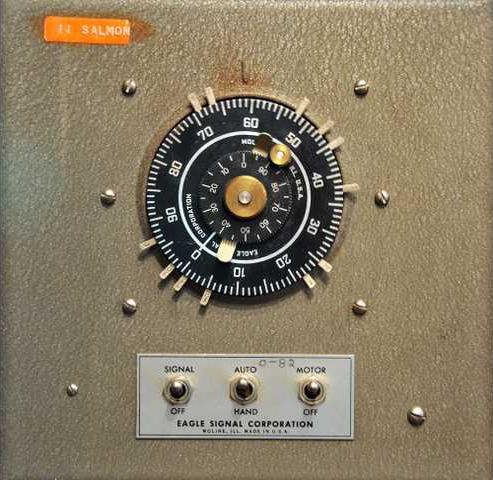0427TRAFFICAUD
Listen as Dee Taylor talks about cameras at intersections, and hear his traffic lights and controllers as they click in his office.Dee Taylor’s engineering career has been full of planes, trains and automobiles.
But for the past six years, he has been able to settle into his favorite of them all — traffic flow.
A childhood infatuation with anything traffic related inspired a lifelong love of traffic signals, lights, signs, catalogs, drink coasters and controllers, among other collectibles.
“I started when I was 6 collecting, and I’m 40 now, so in 34 years you can collect a lot of junk,” said Taylor, traffic engineer for Gainesville. His first piece was a pavement marker, he said.
“On family vacations I would take pictures of traffic signs, signals and markers ... I learned about traffic intervals when I was 6 and 7 ’cause I would just sit there and read these technical memorandums and so my parents, they basically sat back and let me explore.”
Taylor went to the University of Georgia and after college worked with Delta. He then worked for Southern Railway, which is now Norfolk Southern, and worked his way up to locomotive engineer.
“I left that and went into traffic consulting, for two different consulting firms, and then traffic signal timing design,” he said.
Luckily for Taylor, he was working an internship with Athens-Clarke County during the years Atlanta was preparing for the 1996 Olympics.
“A few in particular took me under their wing and I was able to learn a lot about design and learn projects,” said Taylor, who added that the traffic signals in our area were between 20 and 50 years old in the mid-1990s. “There was a lot of traffic work at the time. It was a very neat time in our field because the money was there. It was great — it was a real high, to be quite honest, because we had all this political interest.”
Today, Taylor has a collection of 160 traffic signals and controllers. He keeps 140 in his basement and the others are dispersed between his office and home. You can even find a traffic signal in his backyard, alongside the children’s swing set.
All the signals set up in his home and his office are plugged in, so he can turn them on and demonstrate the lights for guests.
“It’s immaculate ... he’s got an awesome collection,” said Steven Phillips, a traffic technician with the city. “We all are into the signals — that’s why we chose to be in this business. It’s nice to see some of the stuff that he has from the ’20s, ’30s, ’40s.”
Taylor even helped Phillips acquire his first traffic signal, now at Phillips’ home.
“It’s a 3M head, it’s a rare head. Dee helped me get it and I restored it, too,” he said. A 3M head is a kind of traffic signal.
Taylor has restored most traffic artifacts he owns, as well. “I always strip them down, repaint them, and then I might do a little relief lettering on them,” said Taylor, who added that he has a traffic signal and controller in almost every color. “My eventual goal is I would like to have one room — (even) a warehouse — where I could hang all this stuff up and have sort of a Jay Leno-esque (display).”
Some traffic signals even have their original sales pamphlets, so Taylor said he could set up a museum-like setting.
For many years, though, Taylor thought his collection was one-of-a-kind. But he learned otherwise when the Internet became a popular tool for connecting with other traffic-light hobbyists.
“You get to know other people. There’s about 150 others of us in the world,” he said. “We’ve got an Internet club and we trade stuff between each other and that’s how I’ve gotten a lot of my West coast stuff.”
Taylor not only is wild about traffic signals at his home, he also has the obsession for his job in Gainesville. He has been one of the lead project designers for the new traffic signals that are popping up all over the city.
“We are trying to go international and more understanding of (newer traffic signals), but we want everyone to understand that red still means red,” he said, remarking on the simple, more worldly design that’s being installed. He added that what’s been replaced so far makes him happy.
“It looks great; the square looks great.”




